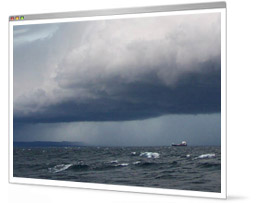My UPD8
You need to login before you download the free activities. You can register here.
- The Centre for Science Education
- The Association for Science Education
- Partners
- Part of ASE online
Making Rain

Type: Activity
Learning Strategy: Modelling
Topic: States of matter
This winter was the driest in Britain since 1933/4. Summer water shortages are expected, and hosepipe bans likely. So can we solve the problem by making rain? In this activity students learn about the significance of droplet size in natural rain formation. They then look at Chinese experiences of 'cloud seeding' before annotating a graphic to show how it works.
Published: 23rd April 2005
Reviews & Comments: 5
Learning objectives
To use the particle model to explain how rain is made and how cloud seeding works
Try the activity
- Making Rain Teachers Notes
Downloaded: 3034 times - Making Rain Activity
Downloaded: 5047 times
You will need Acrobat Reader installed to open the activity sheets.
Curriculum link
7g particle model – use the particle model to explain changes of stateRunning the activity
Page 1 sets the context, and suggests some unusual ways of summoning rain. Page 2 – in the form of a comic strip – explains the process of natural cloud formation and describes Chinese experiences of 'cloud seeding'. The particle model, changes of state and droplet size are emphasised. The activity is on page 3. Students cut out labels and particle diagrams and stick them in appropriate places on the graphic. In so doing, they create a visual explanation of natural and 'seeded' rain formation.
Cloud seeding experiments began at least 50 years ago – but have not always been successful! Many countries now have cloud seeding programmes, including China, South Africa, Mexico and the United Arab Emirates. This activity does not mention problems associated with making rain artificially – see the weblinks below for discussion of some of the issues.
Web links
News links
- New Scientist
- This article focuses on Chinese and South African experiences of cloud seeding. It is detailed and comprehensive, and includes interesting information about experimental techniques. Controversial aspects of cloud seeding are highlighted, too.
- New Scientist - graphic
- This series of diagrams clearly illustrates the stages of both natural and artificial rain production.
- Weatherwizkids
- This is a very student-friendly site about weather phenomena
Reviews & Comments
Write your online review to share your feedback and classroom tips with other teachers. How well does it work, how engaging is it, how did you use it, and how could it be improved?
Science
Mar 8th, 2011

Excellent resources and a fun way of learning science through creative thinking.
Reviewer: Maria Vincent
Science resources
Nov 9th, 2009

excellent brilliant students responded well.
Reviewer: Patricia Brooks-Dickens
Making Rain
Mar 30th, 2009

Good thinking activity for end of particles/change of state sequence. The activity is apparently straightforward but the particle representations are relatively difficult and provide an opportunity for discussion and collaboration.
Reviewer: s evans
Chemistry
Jan 28th, 2008

Year 7 pupils found it quite difficult to tell the difference between the meaning of the different figures (ie haze, water vapour etc) and needed quite a lot of help.
Reviewer: Alan Evans
MAking Rain
May 18th, 2006

I used this with my year 7 mixed ability group. The cleverer ones understood the principle behind cloud seeding. The majority needed guidance flling in the rain diagram. I thought the idea was a good one and led on well from the topic. I would make sure that a completed diagram was available for all to check their results.
Reviewer: Bernard Forrester

200 lessons and assessments from as little as £4.95
Related Activities
Chemistry / States of matter
Difficult & Dull / Particles
- Instant ice-cream
- Death of an angel
- Can Science catch a bomber?
- Plane as big as a school
- Life on Enceladus?